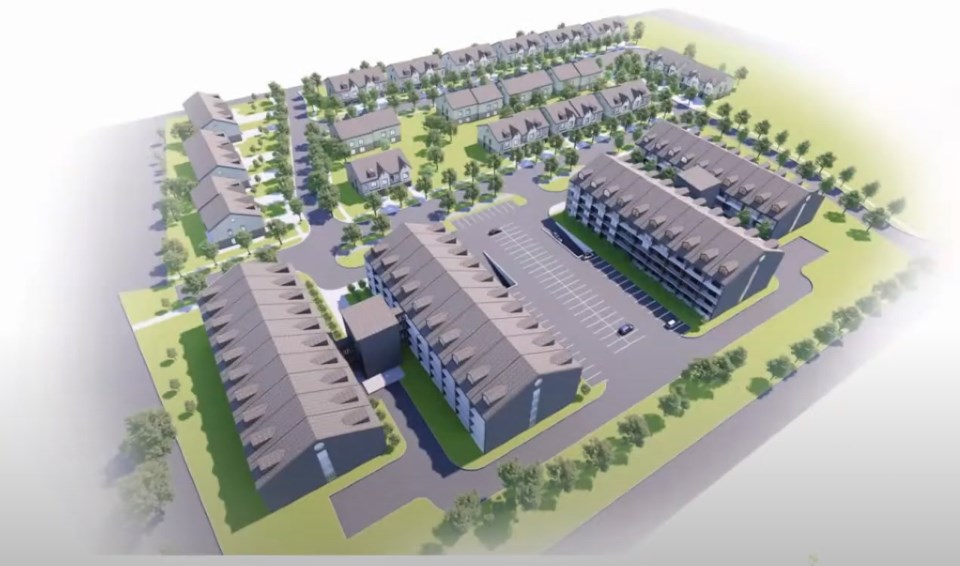Dangling the promise of affordable housing units, one developer is asking to be allowed to build more densely as a trade off.
During council’s committee of the whole meeting on Dec. 4, the proponents behind a proposed development at 560, 580, and 590 Sixth Street came before councillors to ask for approval to amend the zoning bylaw for the land to allow more density, and to get approval for a draft plan of subdivision.
The proposal is for four four-storey apartment buildings consisting of 231 units and 70 townhouse units. A municipal park is also included as part of the draft plan of subdivision.
One of the options considered by councillors this week was to allow the developer to build another storey onto the apartment buildings (five storeys total), and in exchange, the developer would agree to set aside 7.5 per cent of the total units as affordable housing.
Mayor Yvonne Hamlin moved a motion to push the developer further to commit 10 per cent of the units as affordable housing in exchange for a larger density allowance.
“We have limited tools available to us as a municipality to get more affordable housing units,” said Hamlin. “Honestly, I don’t think 10 per cent is significant, however I’m going to support it.”
“If it were up to me, I’d be going for 25 (per cent),” she added.
As part of the zoning and Official Plan amendments requested, part of the Sixth St. land would be rezoned from medium-density residential to recreational use to make way for the park, and the part of the lands where the apartment buildings would stand would be rezoned to high-density residential, which allows 120 units per hectare. This is the maximum density allowed under Collingwood’s Official Plan.
The developer is promising that if the town allows them to increase density to permit 159 units per hectare, they will agree to set aside 7.5 per cent of the apartment units (or 23 units) as affordable housing by adding an extra storey to the apartment buildings.
Through Hamlin’s amendment, the town has countered saying they’ll consider it, if the developer will commit to setting aside 10 per cent of the units (30) to the cause, which was passed unanimously by councillors at their Dec. 4 meeting.
Under the Official Plan, council has the ability to grant an exemption to the density requirements, if a significant portion of affordable housing is part of the plan.
The word ‘significant’ is not defined in the Official Plan.
“It’s open to interpretation,” said the town’s planning director Summer Valentine, also reminding councillors that the town does not have the ability to require any affordable housing in new developments due to provincial regulations.
The Sixth St. proposal last came before council as part of a public meeting back in January to gather feedback from neighbours and the general public, and was not received favourably at that time, with 15 residents speaking against the proposal with more submitting comments following the meeting.
Attendees at that meeting raised issues such as drainage, traffic volumes, parking, whether the new development would be complimentary to the existing neighbourhood and how the new development would impact the values of the adjacent homes.
Some of the residents who spoke at that meeting attended council on Monday to re-iterate their concerns, which they felt hadn’t been addressed through the most recent proposal.
George Marron expressed concern that he hadn’t received adequate notice of Monday’s meeting as a neighbour to the development.
“Only late last week, on Thursday, were we made aware this committee would be meeting to discuss these matters,” said Marron, asking for more time for neighbours to read through all the application documents before a decision is made by council. “Our concerns remain prevalent.”
Marron said he worried about the addition of affordable housing in exchange for permission to build more density.
“It’s being presented, in my respectful view, as a bit of a red herring,” he said. “I don’t think we should be falling for it.”
Doug Mitchell, also a neighbour to the proposed development, asked when the affordable housing units would be built. According to planning staff, if the plans are approved, the development would be built in three phases: phase one would be the 70 townhomes, while phases two and three would be the apartment buildings. The phases would commence construction depending on water servicing capacity constraints. Mayor Yvonne Hamlin put forward an amendment on Monday that the affordable housing units would be built as part of phase two, which was passed by the committee.
“Affordable housing will only come after the townhouses have been built, and not the other way around,” warned Mitchell.
Ian Cartwright echoed Marron’s concerns about notice.
“There’s no talk about what (affordable housing) is or how it will be administered. Will it be by prescribed rent control, or by selling units below market value, or by other means?” asked Cartwright. “Each has different risks and consequences.”
Chief administrative officer Sonya Skinner clarified that when it came to providing notice to residents on pending development files, the town does provide it, although perhaps not as much as some may prefer.
She said it can be a challenge as the town deals with tight turnaround times to address with applications due to provincial planning regulations, with penalties for the town if they do not comply.
“One thing we struggle with – and all municipalities struggle with – is to meet the timelines in the Planning Act,” said Skinner. “We’re really challenged to make sure council has enough time to make a decision.”
The committee voted unanimously in favour of granting the density exemption through a zoning bylaw amendment and Official Plan amendment, conditional on the developer agreeing to commit 10 per cent of the units as affordable housing. Coun. Kathy Jeffery was absent from the meeting.
The decision will need to be ratified at the next regular meeting of council on Dec. 18 before going into effect.
